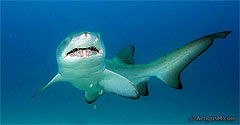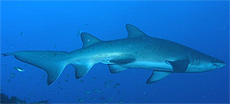Victoria: A Shark on the Critical List - The Grey Nurse Shark (Carcharias taurus)
Mark Rodrigue, MESA Victoria
Grey Nurse Sharks have an extremely well developed sense of smell that includes a sixth sense for picking up small electrical signals such as those that carry nerve impulses inside the bodies of other animals.
Not only can they detect prey in the water through their nostrils but they also have a series of pits under their heads that allow then to be able to detect electric currents in their environment. Each pit is connected to a special organ known as the Ampulae of Lorenzii. These can be used to find fish and invertebrates in the dark or those that are buried below the sand. |

Image courtesy Aengus Moran |
As described in the section on reproduction baby Grey Nurse Sharks develop inside their mother’s body with one pup developing in each uterus. Like most sharks the embryos hatch out from eggs and inside the mother’s body. While some sharks lay eggs that hatch outside the mothers body, many species produce eggs that are fertilised and hatch internally.
The unusual aspect of Grey Nurse Shark reproduction begins once the baby sharks hatch from eggs inside the mother’s uterus. When the developing sharks reach around 10 cm in size they develop teeth and begin to feed on other embryos in the uterus (that’s right they eat their brothers and sisters!!). This unusual method of providing food for the baby sharks leaves only one baby shark developing in each uterus. This is called “intrauterine cannibalism” and is a way of ensuring that only the strongest baby sharks will be born. The single embryo remaining in each uterus then feeds on unfertilised eggs that the mother continues to produce throughout the pregnancy.
Where can you see them?
As previously indicated sightings of Grey Nurse Sharks in Victoria are very rare these days with most sightings occurring in the far east of the state. The only reliable place to see a Grey Nurse Shark in Victoria is in the Melbourne Aquarium where a number of these animals are kept.
Grey Nurse Sharks are a coastal species and generally live in shallow coastal waters from the surf zone down to 60 m, although it has been recorded from water as deep as 190 m. During the day, they are generally found in the vicinity of drop offs, caves and ledges. These locations can have many animals all moving slowly or sitting still in the currents maintaining a flow of water over there gills. At night they move out from these areas to feed in nearby waters
|

Male Grey Nurse Shark
Image courtesy Ron Henry |
In NSW a number of locations are recognised as important Grey Nurse Shark habitat and protection of these areas has been sought. Places like the Solitary Isles near Coffs Harbour, Fish Rocks, Seal Rocks near Kempsey, Forster, Port Stephens, Sydney, Batemans Bay and Narooma.
A number of tour operators run trips for SCUBA divers to visit Grey Nurse Sharks at some of these locations. Divers visiting groups of Grey Nurse Shark are keen to see the size and grace of these large animals that often lie almost motionless in currents.
next ...
|
|



